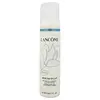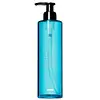What's inside
What's inside
 Benefits
Benefits

 Concerns
Concerns

 Ingredients Side-by-side
Ingredients Side-by-side

Water
Skin ConditioningSorbitol
HumectantGlycerin
HumectantSodium Cocoyl Glycinate
CleansingPEG-8
HumectantHexylene Glycol
EmulsifyingPotassium Laurate
EmulsifyingPotassium Myristate
EmulsifyingPEG-32
HumectantPropylene Glycol
HumectantMethylparaben
PreservativePhenoxyethanol
PreservativeTriethanolamine
BufferingParfum
MaskingDisodium EDTA
Limonene
PerfumingLinalool
PerfumingButylphenyl Methylpropional
PerfumingBenzyl Salicylate
PerfumingAnanas Sativus Fruit Extract
Skin ConditioningCarica Papaya Fruit Extract
Skin ConditioningWater, Sorbitol, Glycerin, Sodium Cocoyl Glycinate, PEG-8, Hexylene Glycol, Potassium Laurate, Potassium Myristate, PEG-32, Propylene Glycol, Methylparaben, Phenoxyethanol, Triethanolamine, Parfum, Disodium EDTA, Limonene, Linalool, Butylphenyl Methylpropional, Benzyl Salicylate, Ananas Sativus Fruit Extract, Carica Papaya Fruit Extract
Water
Skin ConditioningSodium Cocoyl Glycinate
CleansingCoco-Betaine
CleansingGlycerin
HumectantAcrylates Copolymer
Pentylene Glycol
Skin ConditioningSodium Chloride
MaskingPropylene Glycol
HumectantHydroxyethylpiperazine Ethane Sulfonic Acid
BufferingPhenoxyethanol
PreservativeSodium Hydroxide
BufferingDisodium EDTA
Citrus Aurantium Dulcis Oil
MaskingLimonene
PerfumingAloe Barbadensis Extract
Skin ConditioningChamomilla Recutita Extract
Skin ConditioningCitric Acid
BufferingWater, Sodium Cocoyl Glycinate, Coco-Betaine, Glycerin, Acrylates Copolymer, Pentylene Glycol, Sodium Chloride, Propylene Glycol, Hydroxyethylpiperazine Ethane Sulfonic Acid, Phenoxyethanol, Sodium Hydroxide, Disodium EDTA, Citrus Aurantium Dulcis Oil, Limonene, Aloe Barbadensis Extract, Chamomilla Recutita Extract, Citric Acid
 Reviews
Reviews

Ingredients Explained
These ingredients are found in both products.
Ingredients higher up in an ingredient list are typically present in a larger amount.
Disodium EDTA plays a role in making products more stable by aiding other preservatives.
It is a chelating agent, meaning it neutralizes metal ions that may be found in a product.
Disodium EDTA is a salt of edetic acid and is found to be safe in cosmetic ingredients.
Learn more about Disodium EDTAGlycerin is already naturally found in your skin. It helps moisturize and protect your skin.
A study from 2016 found glycerin to be more effective as a humectant than AHAs and hyaluronic acid.
As a humectant, it helps the skin stay hydrated by pulling moisture to your skin. The low molecular weight of glycerin allows it to pull moisture into the deeper layers of your skin.
Hydrated skin improves your skin barrier; Your skin barrier helps protect against irritants and bacteria.
Glycerin has also been found to have antimicrobial and antiviral properties. Due to these properties, glycerin is often used in wound and burn treatments.
In cosmetics, glycerin is usually derived from plants such as soybean or palm. However, it can also be sourced from animals, such as tallow or animal fat.
This ingredient is organic, colorless, odorless, and non-toxic.
Glycerin is the name for this ingredient in American English. British English uses Glycerol/Glycerine.
Learn more about GlycerinLimonene is a fragrance that adds scent and taste to a formulation.
It's found in the peel oil of citrus fruits and other plants such as lavender and eucalyptus. The scent of limonene is generally described as "sweet citrus".
Limonene acts as an antioxidant, meaning it helps neutralize free radicals.
When exposed to air, oxidized limonene may sensitize the skin. Because of this, limonene is often avoided by people with sensitive skin.
The term 'fragrance' is not regulated in many countries. In many cases, it is up to the brand to define this term. For instance, many brands choose to label themselves as "fragrance-free" because they are not using synthetic fragrances. However, their products may still contain ingredients such as essential oils that are considered a fragrance.
Learn more about LimonenePhenoxyethanol is a preservative that has germicide, antimicrobial, and aromatic properties. Studies show that phenoxyethanol can prevent microbial growth. By itself, it has a scent that is similar to that of a rose.
It's often used in formulations along with Caprylyl Glycol to preserve the shelf life of products.
Propylene Glycol is an odorless, colorless liquid. As a humectant, it helps skin retain moisture. It also aids in delivering active ingredients.
Another role of this ingredient is preventing a product from melting or freezing. Propylene glycol also adds antimicrobrial properties to a product, elongating product lifespan.
This ingredient is considered an organic alcohol and commonly added into both cosmetics and foods.
Those with sensitive skin or conditions may develop a rash when using this ingredient.
Learn more about Propylene GlycolSodium Cocoyl Glycinate is a cleansing agent. It can be naturally derived or synthetically-created.
As a surfactant, it helps clean your skin by gathering dirt, oil, and other pollutants to be rinsed away more easily.
Water. It's the most common cosmetic ingredient of all. You'll usually see it at the top of ingredient lists, meaning that it makes up the largest part of the product.
So why is it so popular? Water most often acts as a solvent - this means that it helps dissolve other ingredients into the formulation.
You'll also recognize water as that liquid we all need to stay alive. If you see this, drink a glass of water. Stay hydrated!
Learn more about Water